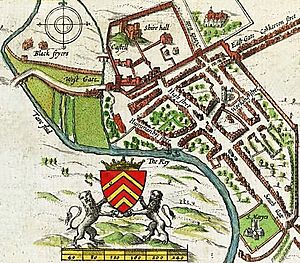St Mary's Church, Cardiff facts for kids
Quick facts for kids St Mary's Church |
|
|---|---|
|
Welsh: Eglwys Fair
|
|

John Speed's 1610 map of Cardiff, showing the southerly location of St Mary's Church, next to the River Taff.
|
|
| Location | Cardiff |
| Country | Wales |
| Previous denomination | Anglican |
| History | |
| Status | Church (former) |
| Founded | 1107 |
| Architecture | |
| Functional status |
|
| Closed | c. 1701 |
| Demolished | 1701 (Ruins) |
St Mary's Church (which in Welsh is Eglwys Fair) was an old Anglican church in Cardiff, Wales. It stood at the south end of what is now St. Mary's Street. The church was built in 1107 and was used until 1620. After being badly damaged by floods, it was left empty in 1701. A new church was built to replace it in a different spot in 1843.
Contents
The Church's Early Days
St Mary's Church started as a Benedictine priory around the 1080s. It was founded by Robert Fitzhamon, who also started Tewkesbury Abbey. However, the church was built very close to the River Taff. This was a bad spot because the area often flooded, and the river slowly wore away the land.
Even after people tried to make the foundations stronger, bodies from the churchyard would often be washed away by the river. Because of these problems, the monks left the priory in 1211.
How the Church Was Destroyed
In 1607, a huge flood hit the areas of England and Wales near the Bristol Channel. This flood was very powerful. Some people think it was caused by a massive storm, while others believe it was a tsunami.
The Great Flood of 1607
The Bristol Channel floods washed away much of St Mary's Church's foundations. This caused the church to slowly start falling apart.
A New Main Church
By 1620, people decided that St John's Church should become the main church for the area. St John's was originally just a smaller church used for special services. Even though St John's became the main church, St Mary's was still used for burials and some church services.
Changes in Leadership
In 1638, the leader of St Mary's Church, William Erbery, had to leave his job. His assistant, Walter Cradock, also lost his permission to preach. Some important members of the church were not allowed inside because they refused to read a book called the Book of Sports.
These people, along with others who thought like them, started a new group. After a big war in England, they were given land in Womanby Street in 1696. This allowed them to build the first Trinity Church, which later became a Presbyterian chapel.
The Church Becomes Ruins
By 1678, visitors like Francis Place and scholar Edward Lhuyd described St Mary's as being in ruins. The church tower fell down in 1680. The last time someone was buried in the churchyard was in 1698. The very last church service was held in the roofless ruins in 1701. After that, St Mary's Church was completely abandoned.
What Happened Next
In 1843, John Crichton-Stuart, 2nd Marquess of Bute gave land for a new church to be built. This new church was called the Church of St. Mary the Virgin. It is now known as the Church of St Mary and St Stephen and is located on Bute Street. People raised money from the public to pay for building it.
Designing the New Church
The 1843 church was designed by Thomas Foster from Bristol. The eastern part of the church was added in 1884 by J. D. Sedding. It was made even bigger in 1907. There are beautiful wall paintings around the arch leading to the chancel (the part of the church where the altar is). This church is now a Grade II listed building, which means it's an important historical building.
Changes to the River Taff
In 1850, the River Taff was moved by Isambard Kingdom Brunel. This was done to create space for building the Cardiff Central railway station. Moving the river also led to the creation of Westgate Street.
A Theatre on the Old Site
In 1878, a building called the Theatre Royal was built on the exact spot where the old St Mary's Church used to be. This theatre later became known as the Prince of Wales theatre. Today, a public house (a pub) called the Prince of Wales stands there. On one wall of the pub, you can still see the outline of a Gothic church. This design reminds people that the pub is built on the site of the old St Mary's Church.
Gallery
See also



